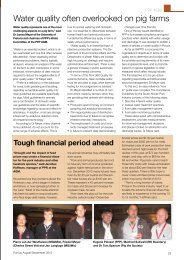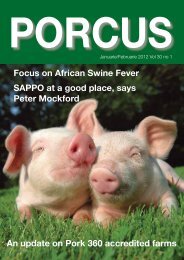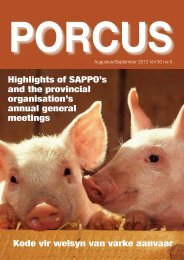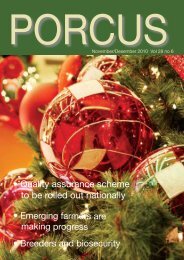porcus - sappo
porcus - sappo
porcus - sappo
Create successful ePaper yourself
Turn your PDF publications into a flip-book with our unique Google optimized e-Paper software.
36<br />
International<br />
Netherlands allowed to export pig<br />
feet to China<br />
The Chinese authorities have formally<br />
allowed as from 1 November<br />
the imports of pig trotters from the<br />
Netherlands.<br />
In June last year, China had already allowed<br />
a limited number of pork products<br />
to be shipped from the Netherlands to<br />
China. At that time, trotters had not been<br />
included yet.<br />
For the full economic valorisation of pig<br />
carcasses, the admission is very important.<br />
Demand for pig trotters is high in<br />
China, with the Chinese New Year coming<br />
up in the beginning of 2013.<br />
UK pork expands to new<br />
Netherlands market<br />
British pork is now being sold in the<br />
largest supermarket chain in the<br />
Netherlands.<br />
The retailer has launched three new lines<br />
including shoulder steaks, fi llet and loin<br />
chops, complete with a high welfare<br />
sticker and a prominent description of<br />
product origin and rearing methods.<br />
The pork is marketed as a product with<br />
high welfare standards and taste in the<br />
retailer’s premium range.<br />
“This is excellent news and recognises<br />
Increase survival of new born pigs<br />
To help increase the survival of new<br />
born piglets, scientists of the United<br />
States (US) department of agriculture<br />
have developed a new method<br />
that predicts animals’ mortality and<br />
nursing ability.<br />
Physiologist Jeffrey Vallet and his colleagues<br />
at the US meat animal research<br />
centre call the measuring technique the<br />
“immunocrit,” which determines whether<br />
preweaning piglets receive adequate<br />
colostrum from the sow. The immunocrit<br />
measures newborn piglet serum immunoglobulin<br />
in blood samples. These<br />
measurements indicate piglets’ mortality<br />
and nursing ability. Immunocrit results<br />
also show that the average measurement<br />
of piglets in a litter refl ects the<br />
The allowance of exporting pig trotters<br />
marks the end of a multi-year project by<br />
the Dutch ministry of economy, agriculture<br />
and innovation, as well as several<br />
Dutch lobby groups and agricultural<br />
organisations.<br />
The Chinese authorities have emphasised<br />
that pig trotters will only eligible<br />
for exporting if the Dutch processing<br />
companies have been approved for<br />
export and are in the possession of an<br />
approved protocol for producing pig<br />
trotters.<br />
Pig Progress<br />
the high standards of the British pork<br />
sector,” said British pig executive export<br />
manager Jean-Pierre Garnier.<br />
“This is a rather prestigious accolade,<br />
particularly as it positions our product<br />
between the supermarket’s own animal<br />
welfare standards and organic pork.<br />
There is a good untapped demand from<br />
Dutch consumers for high welfare and<br />
sustainable meat, and we hope that we<br />
will generate good sales from now on.”<br />
WATTAgNet<br />
sow’s ability to produce colostrum.<br />
In addition, scientists have found a<br />
connection between immunocrit measurements,<br />
piglets’ weight and mortality.<br />
Pigs that weighed more were more likely<br />
to survive the challenge of not getting<br />
colostrum within the critical timeframe,<br />
as opposed to those that weighed less,<br />
said the researchers.<br />
Because test results are obtained so<br />
quickly, it is possible to identify compromised<br />
piglets while they’re still alive,<br />
according to Vallet. The immunocrit<br />
recognises piglets within a litter that<br />
have not eaten or had the chance to<br />
nurse. This provides an opportunity to<br />
save at-risk piglets by using intervention<br />
strategies.<br />
WATTAgNet<br />
A national swine<br />
traceability system<br />
expected before<br />
pig movement<br />
reporting becomes<br />
mandatory<br />
The Canadian Pork Council expects to<br />
have a working pig traceability system<br />
in operation on a voluntary basis in<br />
advance of regulatory changes that will<br />
make the reporting of swine movements<br />
in Canada mandatory.<br />
To accommodate swine traceability,<br />
the Canadian food inspection agency is<br />
revising Canada’s animal health regulations<br />
to for the fi rst time require the<br />
reporting of all movements of pigs.<br />
Jeff Clark, the manager of PigTrace<br />
Canada, an initiative of the Canadian<br />
Pork Council, expects a voluntary system<br />
to be in place before movement<br />
reporting becomes a requirement.<br />
The Pig Site<br />
2013 sow stall ban:<br />
Bigger drop in meat<br />
production<br />
Bigger falls in pig meat production<br />
than originally forecasted are possible,<br />
according to the latest BPEX<br />
report looking at the introduction<br />
of the partial sow stall ban across<br />
Europe on 1 January 2013.<br />
This is the result of rocketing feed costs<br />
and could lead to a sharp rise in prices<br />
for pork and pork products. The report<br />
shows 18 EU countries say they will be<br />
ready for the new legislation, though<br />
some still have a long way to go. The<br />
report shows three possible scenarios<br />
as a result of the changes:<br />
• A fall in pig meat production of around<br />
fi ve per cent from 2011 levels by 2014,<br />
leading to price increases, but with fairly<br />
rapid recovery as productivity improves.<br />
• A sharper fall in production as higher<br />
feed prices add to the impact of the stall<br />
ban, leading to shortages of pig meat<br />
and substantial price increases, resulting<br />
in pressure for political intervention.<br />
• Realignment of production so that<br />
breeding is concentrated in North West<br />
Europe and fi nishing in Eastern and<br />
Southern Europe, reducing overall production<br />
costs.<br />
PigProgress<br />
Porcus Oktober/November 2012







